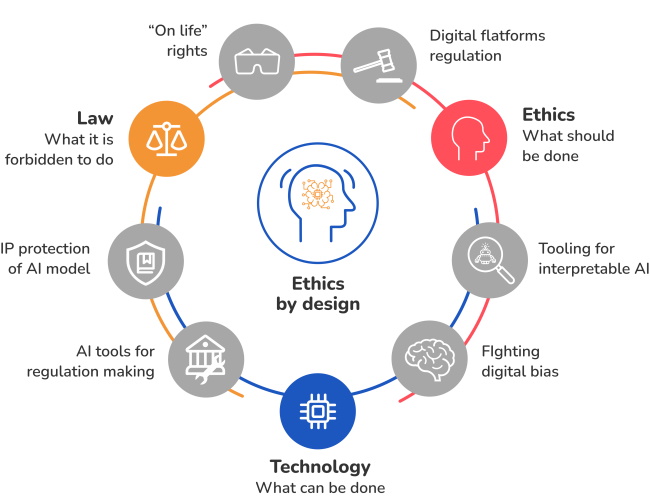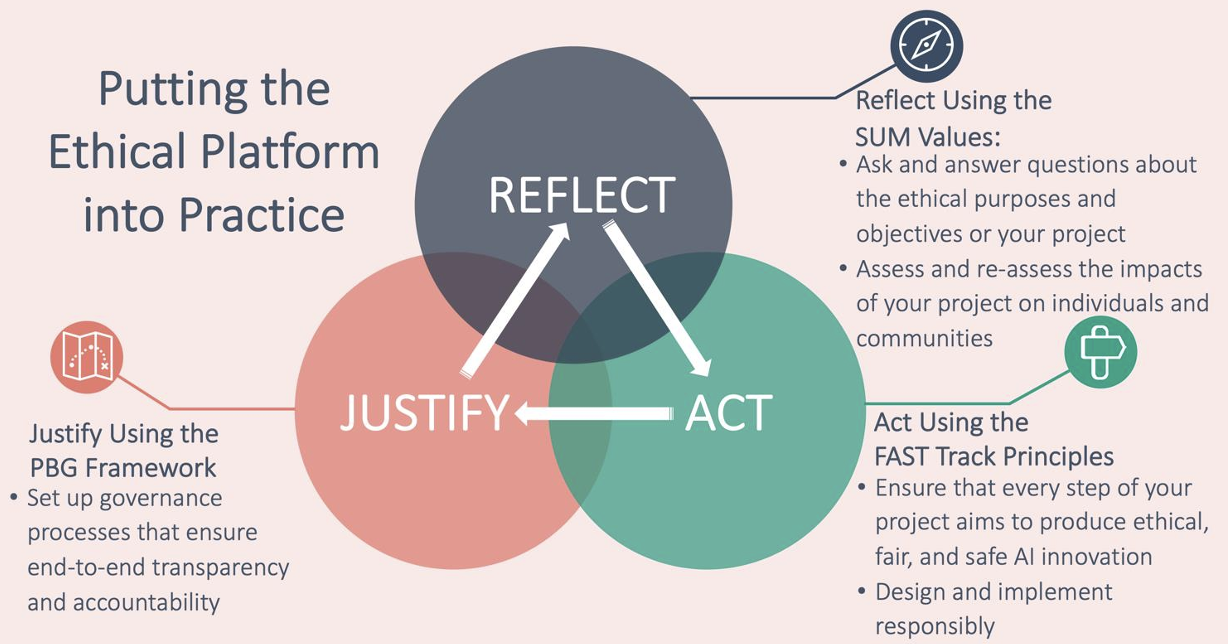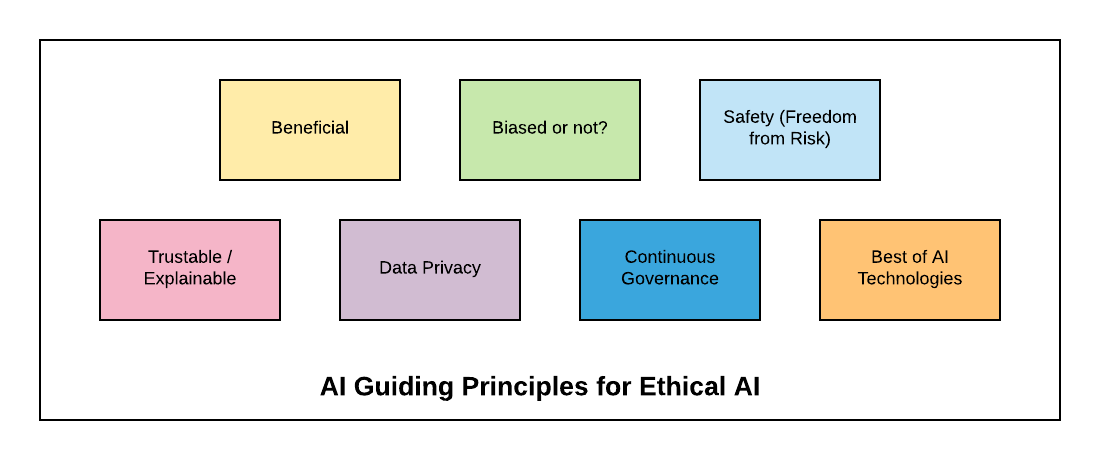TECHNOLOGY
The Role of Tech Companies and Governments in Ensuring Ethical AI Development

Governments and tech companies must ensure that AI systems are inclusive, unbiased, explainable, purposeful, and responsible with data.
The use of artificial intelligence (AI) has become an increasingly important part of our daily lives, from personalized recommendations on streaming services to self-driving cars.
As AI becomes more ubiquitous, so does the potential for its misuse and abuse.
In a recent open letter, tech researchers and CEOs called for an immediate halt to AI system training, such as ChatGPT. Elon Musk, the founder of Twitter, and Steve Wozniak, the co-founder of Apple, are among the high-profile names who have signed an open letter urging the halting of the rollout of artificial intelligence-powered tools like ChatGPT. A letter titled ‘Pause Giant AI Experiments: An Open Letter’ was posted on the Future of Life Institute’s website last Wednesday. “We call on all AI labs to immediately pause training of AI systems more powerful than GPT-4 for at least 6 months,” it said.
As a result, it’s crucial that tech companies take a closer look at the ethical and safety implications of AI to protect users from the dark side of this technology.
The Dark Side of AI: Understanding the Risks and Implications

AI can be incredibly powerful, but it can also be incredibly dangerous. As AI systems become more advanced, they become more autonomous, meaning they can make decisions without human intervention. While this can be beneficial in some cases, it can also lead to unintended consequences.
For example, in 2016, Microsoft launched an AI chatbot called Tay on Twitter. Tay was designed to learn from interactions with other users and improve its responses over time. However, within just a few hours, Tay had learned to spout racist and sexist comments, prompting Microsoft to shut it down.
This incident highlights the potential dangers of AI and the importance of considering the ethical implications of AI development.
Another example is facial recognition technology. While it has many potential applications, including security and identification, it also poses a threat to privacy. This technology could be used to identify individuals without their consent or knowledge, potentially leading to stalking or harassment.
The ethical and safety implications of AI are not limited to these examples. AI systems have the potential to be used in ways that violate human rights, such as surveillance, discrimination, and weaponization.
Ethics and Safety in AI Development: A Vital Concern for Tech Companies
It’s important for tech companies to consider ethics and safety in AI development to protect users from the potential dangers of this technology.
First and foremost, companies must ensure that their AI systems are designed to protect user privacy and security. This means implementing robust security measures and using encryption to protect user data from hackers and other threats.

Companies must also consider the ethical implications of their AI systems. This includes ensuring that their systems are designed to be fair and unbiased, and that they do not discriminate against any groups of people.
For example, facial recognition technology should not be biased against certain racial or ethnic groups. This requires careful testing and validation to ensure that the technology is fair and unbiased.
Another important consideration is the impact of AI on employment. As AI becomes more advanced, it has the potential to automate many jobs, leading to widespread job loss. Companies must consider the impact of their AI systems on employment and take steps to mitigate any negative effects.
Finally, companies must consider the potential misuse of their AI systems. This includes taking steps to prevent the weaponization of AI and ensuring that their systems cannot be used for harmful purposes.
Balancing Innovation and Responsibility in the Era of AI
While it’s important for tech companies to take responsibility for the ethical and safety implications of their AI systems, it’s also important for governments to play a role in regulating the development and use of AI.
The CAIDP claims that OpenAI’s GPT-4 is “biased, deceptive, and a risk to privacy and public safety”. The think tank cited contents in the GPT-4 System Card that describe the model’s potential to reinforce biases and worldviews, including harmful stereotypes and demeaning associations for certain marginalised groups.

GPT4 can process up to 25,000 words per second, which is roughly eight times faster than ChatGPT. Advancements in generative AI and other areas of machine learning are likely to continue in the coming years.
Regulation can help to ensure that AI is developed and used in a responsible and ethical way. This can include setting standards for the development of AI systems, requiring transparency in the use of AI, and providing guidelines for the use of AI in specific industries.
It’s important to state that regulation can also be a double-edged sword. Over-regulation can stifle innovation and make it difficult for companies to develop and deploy AI systems. It’s important to strike a balance between protecting users and allowing for innovation.
The Crucial Role of Regulation in Ensuring Ethical and Safe AI Development

Source: The Alan Turing Institute
As AI becomes more advanced and more ubiquitous, it’s crucial that tech companies take a closer look at the ethical and safety implications of this technology. This includes ensuring that their AI systems are designed to protect user privacy and security, considering the ethical implications of their systems, and taking steps to prevent the misuse of AI.
At the same time, it’s important for governments to play a role in regulating the development and deployment of AI. This includes setting standards for ethical and safe AI, as well as creating legal frameworks to govern the use of AI in sensitive areas such as healthcare, finance, and national security.
One promising approach is to establish multi-stakeholder collaborations that bring together industry, academia, civil society, and government to jointly develop AI standards and guidelines. Such collaborations could help ensure that AI is developed and used in ways that are transparent, trustworthy, and aligned with societal values.
Another important step is to invest in research on AI safety and ethics. This includes exploring ways to ensure that AI systems are robust and resilient, as well as identifying potential risks and developing ways to mitigate them. Research in these areas can help build a solid foundation for the safe and ethical development of AI.
It’s important to raise public awareness about the risks and benefits of AI, and to foster a more informed public debate about the role of AI in society. This includes promoting greater transparency and openness in the development and deployment of AI, as well as engaging with the public to understand their concerns and perspectives.
What is the Future of Ethical AI?

The future of ethical AI is expected to be shaped by a growing awareness of the social and ethical implications of AI technologies. This awareness is driving the development of guidelines and standards for ethical AI, which are designed to ensure that AI is developed and used in a way that is consistent with human values and ethical principles. In addition, the adoption of explainable AI and transparent decision-making processes will become increasingly important, as these technologies will help to build trust and accountability in AI systems. Finally, there will be a continued focus on diversity and inclusivity in AI development, as it is recognized that bias and discrimination can be embedded in AI systems if diverse perspectives are not represented in the development process.
The development and deployment of AI will have far-reaching implications for society. While AI has the potential to bring about significant benefits, it also poses significant risks if not developed and deployed in a safe and ethical manner. By taking a proactive approach to AI ethics and safety, tech companies and governments can help ensure that this technology is used in ways that benefit society as a whole.
TECHNOLOGY
Next-gen chips, Amazon Q, and speedy S3

AWS re:Invent, which has been taking place from November 27 and runs to December 1, has had its usual plethora of announcements: a total of 21 at time of print.
Perhaps not surprisingly, given the huge potential impact of generative AI – ChatGPT officially turns one year old today – a lot of focus has been on the AI side for AWS’ announcements, including a major partnership inked with NVIDIA across infrastructure, software, and services.
Yet there has been plenty more announced at the Las Vegas jamboree besides. Here, CloudTech rounds up the best of the rest:
Next-generation chips
This was the other major AI-focused announcement at re:Invent: the launch of two new chips, AWS Graviton4 and AWS Trainium2, for training and running AI and machine learning (ML) models, among other customer workloads. Graviton4 shapes up against its predecessor with 30% better compute performance, 50% more cores and 75% more memory bandwidth, while Trainium2 delivers up to four times faster training than before and will be able to be deployed in EC2 UltraClusters of up to 100,000 chips.
The EC2 UltraClusters are designed to ‘deliver the highest performance, most energy efficient AI model training infrastructure in the cloud’, as AWS puts it. With it, customers will be able to train large language models in ‘a fraction of the time’, as well as double energy efficiency.
As ever, AWS offers customers who are already utilising these tools. Databricks, Epic and SAP are among the companies cited as using the new AWS-designed chips.
Zero-ETL integrations
AWS announced new Amazon Aurora PostgreSQL, Amazon DynamoDB, and Amazon Relational Database Services (Amazon RDS) for MySQL integrations with Amazon Redshift, AWS’ cloud data warehouse. The zero-ETL integrations – eliminating the need to build ETL (extract, transform, load) data pipelines – make it easier to connect and analyse transactional data across various relational and non-relational databases in Amazon Redshift.
A simple example of how zero-ETL functions can be seen is in a hypothetical company which stores transactional data – time of transaction, items bought, where the transaction occurred – in a relational database, but use another analytics tool to analyse data in a non-relational database. To connect it all up, companies would previously have to construct ETL data pipelines which are a time and money sink.
The latest integrations “build on AWS’s zero-ETL foundation… so customers can quickly and easily connect all of their data, no matter where it lives,” the company said.
Amazon S3 Express One Zone
AWS announced the general availability of Amazon S3 Express One Zone, a new storage class purpose-built for customers’ most frequently-accessed data. Data access speed is up to 10 times faster and request costs up to 50% lower than standard S3. Companies can also opt to collocate their Amazon S3 Express One Zone data in the same availability zone as their compute resources.
Companies and partners who are using Amazon S3 Express One Zone include ChaosSearch, Cloudera, and Pinterest.
Amazon Q
A new product, and an interesting pivot, again with generative AI at its core. Amazon Q was announced as a ‘new type of generative AI-powered assistant’ which can be tailored to a customer’s business. “Customers can get fast, relevant answers to pressing questions, generate content, and take actions – all informed by a customer’s information repositories, code, and enterprise systems,” AWS added. The service also can assist companies building on AWS, as well as companies using AWS applications for business intelligence, contact centres, and supply chain management.
Customers cited as early adopters include Accenture, BMW and Wunderkind.
Want to learn more about cybersecurity and the cloud from industry leaders? Check out Cyber Security & Cloud Expo taking place in Amsterdam, California, and London. Explore other upcoming enterprise technology events and webinars powered by TechForge here.
TECHNOLOGY
HCLTech and Cisco create collaborative hybrid workplaces

Digital comms specialist Cisco and global tech firm HCLTech have teamed up to launch Meeting-Rooms-as-a-Service (MRaaS).
Available on a subscription model, this solution modernises legacy meeting rooms and enables users to join meetings from any meeting solution provider using Webex devices.
The MRaaS solution helps enterprises simplify the design, implementation and maintenance of integrated meeting rooms, enabling seamless collaboration for their globally distributed hybrid workforces.
Rakshit Ghura, senior VP and Global head of digital workplace services, HCLTech, said: “MRaaS combines our consulting and managed services expertise with Cisco’s proficiency in Webex devices to change the way employees conceptualise, organise and interact in a collaborative environment for a modern hybrid work model.
“The common vision of our partnership is to elevate the collaboration experience at work and drive productivity through modern meeting rooms.”
Alexandra Zagury, VP of partner managed and as-a-Service Sales at Cisco, said: “Our partnership with HCLTech helps our clients transform their offices through cost-effective managed services that support the ongoing evolution of workspaces.
“As we reimagine the modern office, we are making it easier to support collaboration and productivity among workers, whether they are in the office or elsewhere.”
Cisco’s Webex collaboration devices harness the power of artificial intelligence to offer intuitive, seamless collaboration experiences, enabling meeting rooms with smart features such as meeting zones, intelligent people framing, optimised attendee audio and background noise removal, among others.
Want to learn more about cybersecurity and the cloud from industry leaders? Check out Cyber Security & Cloud Expo taking place in Amsterdam, California, and London. Explore other upcoming enterprise technology events and webinars powered by TechForge here.
TECHNOLOGY
Canonical releases low-touch private cloud MicroCloud

Canonical has announced the general availability of MicroCloud, a low-touch, open source cloud solution. MicroCloud is part of Canonical’s growing cloud infrastructure portfolio.
It is purpose-built for scalable clusters and edge deployments for all types of enterprises. It is designed with simplicity, security and automation in mind, minimising the time and effort to both deploy and maintain it. Conveniently, enterprise support for MicroCloud is offered as part of Canonical’s Ubuntu Pro subscription, with several support tiers available, and priced per node.
MicroClouds are optimised for repeatable and reliable remote deployments. A single command initiates the orchestration and clustering of various components with minimal involvement by the user, resulting in a fully functional cloud within minutes. This simplified deployment process significantly reduces the barrier to entry, putting a production-grade cloud at everyone’s fingertips.
Juan Manuel Ventura, head of architectures & technologies at Spindox, said: “Cloud computing is not only about technology, it’s the beating heart of any modern industrial transformation, driving agility and innovation. Our mission is to provide our customers with the most effective ways to innovate and bring value; having a complexity-free cloud infrastructure is one important piece of that puzzle. With MicroCloud, the focus shifts away from struggling with cloud operations to solving real business challenges” says
In addition to seamless deployment, MicroCloud prioritises security and ease of maintenance. All MicroCloud components are built with strict confinement for increased security, with over-the-air transactional updates that preserve data and roll back on errors automatically. Upgrades to newer versions are handled automatically and without downtime, with the mechanisms to hold or schedule them as needed.
With this approach, MicroCloud caters to both on-premise clouds but also edge deployments at remote locations, allowing organisations to use the same infrastructure primitives and services wherever they are needed. It is suitable for business-in-branch office locations or industrial use inside a factory, as well as distributed locations where the focus is on replicability and unattended operations.
Cedric Gegout, VP of product at Canonical, said: “As data becomes more distributed, the infrastructure has to follow. Cloud computing is now distributed, spanning across data centres, far and near edge computing appliances. MicroCloud is our answer to that.
“By packaging known infrastructure primitives in a portable and unattended way, we are delivering a simpler, more prescriptive cloud experience that makes zero-ops a reality for many Industries.“
MicroCloud’s lightweight architecture makes it usable on both commodity and high-end hardware, with several ways to further reduce its footprint depending on your workload needs. In addition to the standard Ubuntu Server or Desktop, MicroClouds can be run on Ubuntu Core – a lightweight OS optimised for the edge. With Ubuntu Core, MicroClouds are a perfect solution for far-edge locations with limited computing capabilities. Users can choose to run their workloads using Kubernetes or via system containers. System containers based on LXD behave similarly to traditional VMs but consume fewer resources while providing bare-metal performance.
Coupled with Canonical’s Ubuntu Pro + Support subscription, MicroCloud users can benefit from an enterprise-grade open source cloud solution that is fully supported and with better economics. An Ubuntu Pro subscription offers security maintenance for the broadest collection of open-source software available from a single vendor today. It covers over 30k packages with a consistent security maintenance commitment, and additional features such as kernel livepatch, systems management at scale, certified compliance and hardening profiles enabling easy adoption for enterprises. With per-node pricing and no hidden fees, customers can rest assured that their environment is secure and supported without the expensive price tag typically associated with cloud solutions.
Want to learn more about cybersecurity and the cloud from industry leaders? Check out Cyber Security & Cloud Expo taking place in Amsterdam, California, and London. Explore other upcoming enterprise technology events and webinars powered by TechForge here.
-

 SEARCHENGINES7 days ago
SEARCHENGINES7 days agoGoogle Core Update Volatility, Helpful Content Update Gone, Dangerous Google Search Results & Google Ads Confusion
-

 SEO6 days ago
SEO6 days ago10 Paid Search & PPC Planning Best Practices
-

 MARKETING5 days ago
MARKETING5 days ago5 Psychological Tactics to Write Better Emails
-

 SEARCHENGINES5 days ago
SEARCHENGINES5 days agoWeekend Google Core Ranking Volatility
-

 SEO6 days ago
SEO6 days agoWordPress Releases A Performance Plugin For “Near-Instant Load Times”
-

 MARKETING6 days ago
MARKETING6 days agoThe power of program management in martech
-
SEARCHENGINES4 days ago
Daily Search Forum Recap: April 15, 2024
-

 PPC4 days ago
PPC4 days ago20 Neuromarketing Techniques & Triggers for Better-Converting Copy















